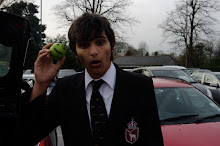Understanding the Conventions of an opening Film
The Bourne Identity, 2002, Directed by Doug Liman
To understand the conventions of an opening film I will refer to the first 5 and a half minutes of Doug Liman’s 2002 film,”The Bourne Identity,” a spy thriller starring Matt Damon.
The film starts with the Universal Ident to signify it as the production company. Atmos affects of rain and whistling wind are played during this sequence as a sound bridge. The use of pathetic fallacy to set up the mood of the opening scene in indicative of the genre; a thriller.
The Establishing shot shows an unidentified character floating in the sea from underneath the water, Lighting and rain can be seen above the surface of the water, here the heavy use of pathetic fallacy can be observed which further creates a dark unnerving and unsettling mood.
During this sequence non diegetic music gradually fades up on the soundtrack, the use of a pedal in the score heightens the drama and builds up tension. The use of hand held camera technique as the fishermen on the boat are first introduced reenacts the motion caused by the violent storm rocking the boat and adds to the unsettling mood being constructed.
The use of eye line match when a character goes out onto the boat and looks out to sea introduces the Main character; Jason Bourne. It is after this shot that the title of the film is shown. A dissolve to black is followed by a super imposed title which appears to ‘float’ up to the front of the screen, obviously referring to the opening setting of the film. The font used for the title is a futuristic looking font which fits in with the idea of it being a spy film.
High angle shots and canted angle shots show the main character being lifted onto the boat, the use of unconventional camera angles help to give the scene an unnerving feel. A change in the non-diegetic score also helps to do this. The use of syncopated drum fills add drama to the music, as the does the arpeggio and occasional accented notes all adding to create a much more exciting opening sequence filled with suspension and also heightens the anticipation of the audience for what will happen next.
The pace of cuts quickens as Bourne is carried down into the boat, this coupled with the extensive use of hand-camera technique adds realism and allows the audience to be wrapped up in the narrative through willing suspension of disbelief. There is accelerando in the music as the tempo speeds up, speeding up the pace and excitement of the scene. The lack of continuity editing and jump cuts quickens the pace of the opening sequence raising the levels of anticipation of what will happen next from the audience.
The tempo of the music slows down and a pedal is reintroduced as Bourne’s wet suit is slowly cut. The sound of the creaking of the boat helps to add an eerie vibe to this scene. A close up shows his wetsuit being pulled away to reveal two bullet holes in his back, the then cuts to a reaction shot of the fisherman looking after him. As this happens a single high pitch discordant note is heard which emphasises the eeriness of that particular moment. Later on in the scene the camera follows the fisherman through to where Bourne was laying unconscious on the table moments ago, when he gets there, a whip pan moves from him to the table to reveal that Bourne is no longer there. A shot then shows him being grabbed by Bourne as he shouts “What are you doing to me?” a the music drastically changes in pace to a very short electric guitar fill-in as he pushes the fisherman into a wall and starts to interrogate him. The large number of cuts during the sequence controls the flow action and makes it very fast and frantic. The use of held-held technique here reinforces the realism and action of the scene. The scene ends with a shot of Bourne being asked his name to which he replies, “I don’t know.” The shot for this last bit is a Medium close up and is held for a longer amount of time than other shots in the sequence, drawing the opening scene to a close.
Overall, the use of a non diegetic score helped to add serious tension and drama to the opening scene. The extensive use of sound effects which contributed to the pathetic fallacy created an eerie and unnerving mood about the scene. And the extensive use of hand-held camera technique added a sense of realism to the scene.

No comments:
Post a Comment